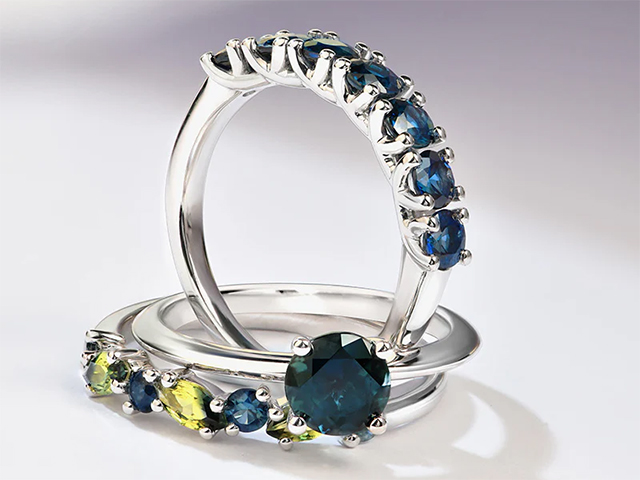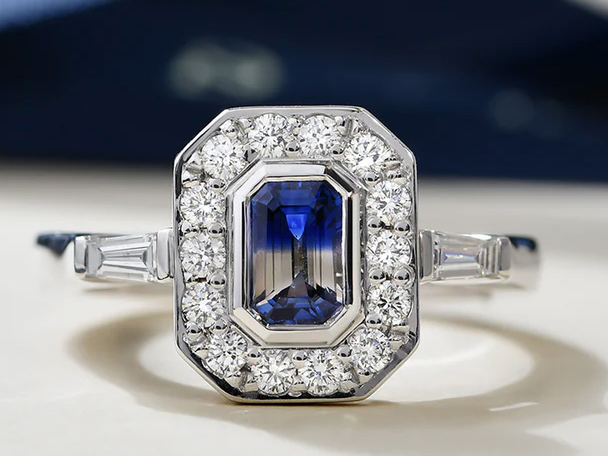Historical Significance: Royal Sapphire Engagement Rings Through the Ages

Engagement rings have long been a symbol of love and commitment, and throughout history, they've also served as a marker of status, wealth, and royal lineage.
Among the most captivating and historically significant of these rings are those set with sapphires " precious gemstones that have adorned the fingers of royalty for centuries.
In this article we explore the fascinating history of royal sapphire engagement rings, tracing their growing significance through the ages.
How Are Sapphires Formed?
Sapphire is a precious gemstone, a variety of the mineral corundum, consisting of aluminium oxide with trace amounts of elements such as iron, titanium, cobalt, lead, chromium, vanadium, magnesium, boron, and silicon.
The trace elements within the corundum help to make what is called a colour centre, or the part of the mineral that gives off the characteristic colour of each gemstone.
Corundum is one of the strongest and hardest minerals on earth and therefore produces high quality precious stone pieces. Sapphires have large crystal structures with various types of internal patterns such as starred structures or needling. They also have great refractive qualities which contribute significantly to their beauty.
Although blue is the best-known sapphire colour, it occurs in other colours, including grey and black, and also can be colourless. A pinkish orange variety of sapphire is called padparadscha.
The Allure of Sapphires: A Royal Tradition
Given their intense beauty and rarity, sapphires have been cherished for thousands of years, often associated with nobility, wisdom, and divine favour.
Their rich, deep blue hue"symbolic of both the heavens and the oceans"has made them a favourite among royals.
The tradition of using sapphires in engagement rings dates back to ancient civilizations, where they were believed to protect wearers from envy and harm, ensuring a pure and honest love.
The etymology of the word sapphire is that it is a derivative of the Latin word for blue sapphirus, itself from the Greek word sappheiros, which referred to lapis lazuli. During the Medieval Ages, European lapidaries (or gemcutters) came to refer to blue corundum crystal by "sapphire".
Medieval Majesty: The Rise of Sapphires in Royal Jewels
During the Medieval period, sapphires became increasingly popular among European royalty. These gemstones were often chosen for their supposed protective powers and their representation of loyalty and faithfulness " qualities highly valued in royal marriages.
Kings and queens across Europe wore sapphires both as a sign of extreme wealth and as a testament to their divine right to rule.
One of the most notable instances of a sapphire in a royal wedding / engagement jewellery item is believed to be Queen Victoria's famous sapphire and diamond brooch, given to her by Prince Albert. The brooch was designed by Garrard, the London-based jeweller behind many of the royal family's treasures. A wedding gift from her beloved Albert, Victoria wore the brooch proudly in her bridal portrait.
It is clear that sapphires were a favoured gemstone in the Victorian era - and in this case - reflected the queen's deep love for her husband and their shared values.
The 20th Century: Sapphires in the Modern Royal Court
The 20th century saw a resurgence in the popularity of sapphire engagement rings, particularly within the British royal family.
The most iconic of these is, without doubt, the engagement ring given to Lady Diana Spencer by Prince Charles in 1981. The ring, featuring a 12-carat oval blue sapphire surrounded by 14 solitaire diamonds, was a departure from traditional royal engagement rings, which typically featured only diamonds. Lady Diana's choice was both a nod to tradition and a reflection of her unique personality.
This ring, later worn by Catherine, Duchess of Cambridge, upon her engagement to Prince William, has become one of the most famous and recognizable pieces of jewellery in the world. It symbolises not only the continuation of royal heritage but also the timeless appeal of sapphires as a gemstone of choice for those who wish to honour tradition while making a personal statement.
Sapphires in the 21st Century: A Continuing Legacy
In recent years, royal sapphire engagement rings have continued to captivate the public's imagination.
The ring that once belonged to Princess Diana and is now worn by Kate Middleton has inspired countless replicas and has reinforced the sapphire's status as a symbol of royal elegance and timeless love.
Sapphires have also become a popular choice for modern royals and celebrities alike, drawn to the gemstone's rich history and its association with regal sophistication.
The popularity of sapphire engagement rings in the 21st century highlights their significance not just as a fashion statement but as a continuation of a legacy that spans centuries.
Conclusion: The Timeless Charm of Royal Sapphires
Royal sapphire engagement rings are stunning pieces of jewellery and symbols of enduring love, commitment, and tradition.
From the medieval courts of Europe to the modern-day British monarchy, sapphires have graced the fingers, necks and wrists of royals, embodying the qualities of loyalty, wisdom, and divine protection.
As these precious stones continue to capture the hearts of new generations, they remind us of the timeless and historical significance of sapphires in the world of royalty.

MORE





